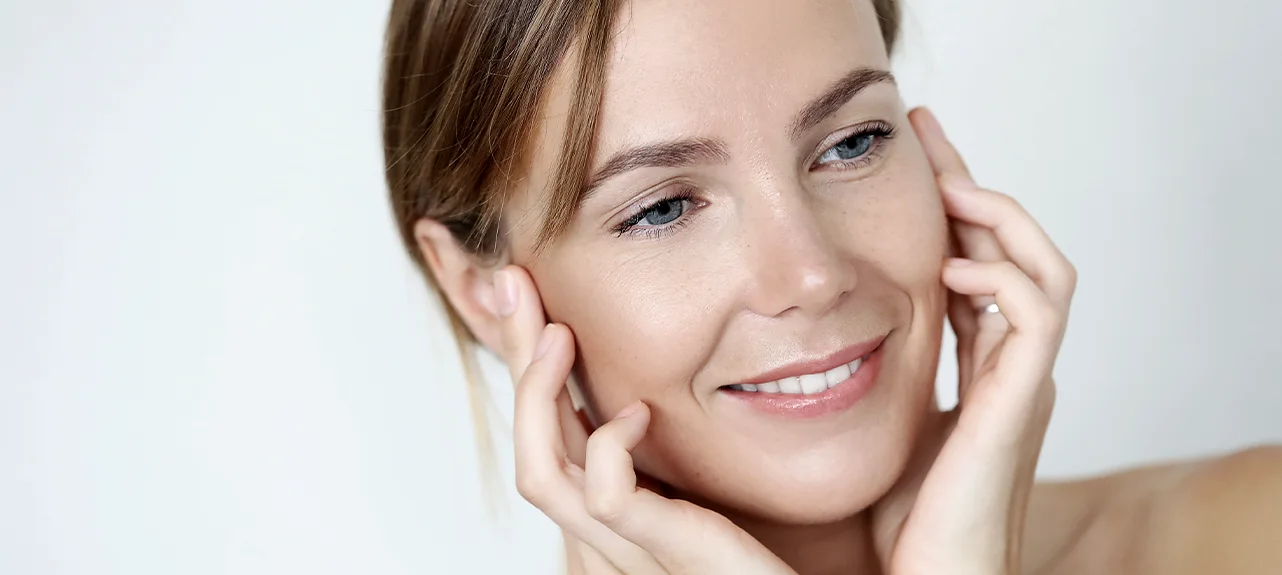Teeth Whitening. Smile Bold.
Only for boundary-breakers .

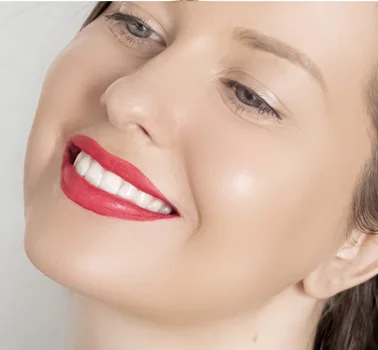
Beyond the dentristy.
If you've ever lost a tooth or needed a replacement, you might have heard about Teeth Whitening.
They are a popular solution that not only looks and feels like your natural teeth but also offers long-term benefits. In this page, we’ll walk you through everything you need to know about teeth Whitening in a simple and easy-to-understand way.
Teeth Whitening
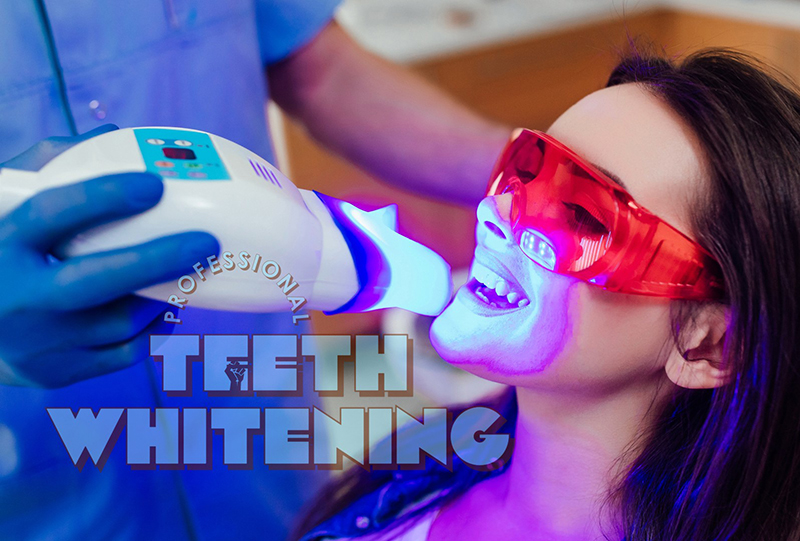
Teeth whitening procedures provide your teeth a brighter, whiter smile without causing harm to your gums, tooth enamel, or teeth themselves. Nowadays, more and more people are opting for laser teeth whitening procedures since they are more effective, take less time, and can even whiten teeth while protecting them from damage.
You can whiten your teeth at home with or without a dentist's supervision; the choice is yours. Of course, there is a limit to how well any treatment works for specific individuals.
Teeth whitening is an aesthetic procedure performed to lighten the colour of the teeth. Its popularity has skyrocketed in recent years, in part because of the growing number of people concerned about their dental health and how they look. At its core, teeth whitening entails three distinct approaches.
Home whitening:
An at-home whitening procedure involves the long-term application of a gel containing a small amount of either hydrogen peroxide (HP) or carbamide peroxide (CP). The patient uses custom-made trays to apply the whitening gel to their teeth before the procedure.
Office whitening:
Whitening in the dentist's office involves the rapid application of whitening products containing high concentrations of hydrogen peroxide. This process typically makes use of a laser or other light source to enhance the whitening gel's efficacy. Quick results, care of delicate tissues, and dentist monitoring are some of the benefits of this approach.
Laser-assisted teeth whitening:
Laser technology greatly enhances the effectiveness of teeth whitening when utilised alongside more traditional whitening techniques by speeding up the whitening agent's chemical reactions. This method can result in significantly whiter teeth in a shorter period of time.
In recent years, teeth whitening has exploded in popularity due to the widespread belief that having white teeth indicates a person is younger, more well-off, and more health-conscious. People nowadays are looking for ways to improve the aesthetics of their smile.
Tooth sensitivity, enamel structural abnormalities, and discolouration of restorative materials are some of the side effects that may occur after teeth whitening treatments. Although some of these side effects may be bothersome at first, you should know that they are usually mild and temporary.
Teeth whitening procedures might cause enamel to change in some ways. Some of these changes could include: bleaching solutions containing large amounts of HP or CP have the ability to lower enamel microhardness, according to research. (1) The surface of the enamel could become roughened by bleaching. Enamel structure can develop pores. Alterations to the mineral composition of the enamel can occur during whitening.
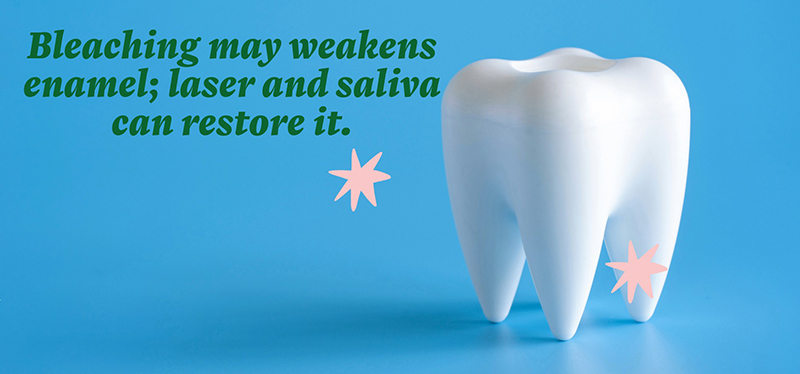
Especially high concentrations of bleaching agents can cause erosion of the enamel surface. Enamel may become more susceptible to abrasion after bleaching.
The enamel structure can be preserved or even strengthened with laser-assisted whitening, according to some studies. (1) Research has shown that low-power diode lasers can defend against structural alterations in enamel and even boost its crystallinity. Some research suggests that saliva's remineralisation impact can gradually remineralise the enamel's surface pores.
Both "teeth whitening" and "teeth bleaching" describe the same procedure—lightening the shade of teeth—and are so commonly used interchangeably. The more informal "teeth whitening" is preferred over the more technical "teeth bleaching," which draws attention to the chemicals utilised. Tooth discolouration removal treatments are referred to by both names. Laser-assisted whitening is a subset of this broader procedure that involves lightening tooth colour with laser technology.
For a variety of reasons, people feel the urge to whiten their teeth. Commonly, these factors have to do with how people see things aesthetically and how society views them. Reasons to whiten your teeth include the following:
Aesthetic Appearance:
The general public tends to view those with whiter teeth as more beautiful and younger. Factors including smoking, certain foods, and beverages (coffee, tea, wine, etc.) can cause teeth to change colour with time. In order to restore a person's self-esteem, teeth whitening is a great option for removing discolourations.
Social Perceptions:
White teeth are seen as a symbol of youth, health consciousness, and social standing, among other favourable attributes. So, teeth whitening is a great way for people to boost their confidence and look their best in social situations.
Increased Self-Confidence:
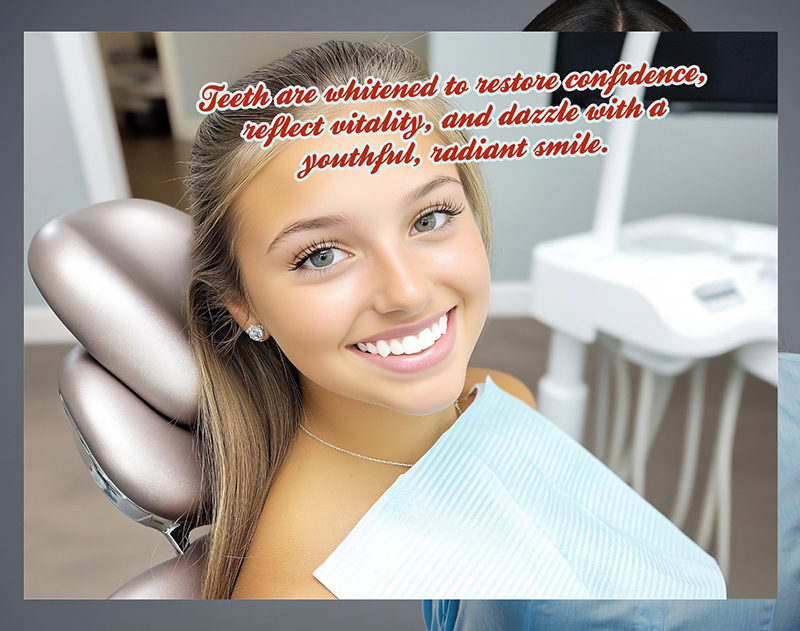
People who are self-conscious about their teeth's colour may struggle to smile confidently. Whitening one's teeth can improve one's self-esteem and make smiling more natural, which in turn boosts confidence.
Special Occasions:
Teeth whitening is a popular choice for those who want to improve their appearance before important events like weddings, graduations, or job interviews. People may become more concerned about how they look in such circumstances.
Perception of Dental Health:
To some, pearly whites are a sign of good dental hygiene. Although there is no causal relationship between tooth colour and oral health, people may be more cautious about their oral hygiene habits if they have white teeth.
Complementing Existing Treatments:
Following certain dental procedures, including orthodontic therapy or dental restorations, teeth may exhibit discolouration. Teeth whitening can eliminate these discolourations and enhance the cosmetic appeal of the treatment results.
Masking Demineralization Areas:
Teeth can look less than ideal if they have demineralised patches or white spot lesions. Whitening your teeth can make them look whiter and hide such lesions.
Smile Aesthetics:
Tooth whitening is a common method for improving the appearance of a person's smile. Increasing numbers of people are opting to whiten their teeth because of the positive impact it can have on their social and professional lives.
Tooth discolouration might have inner or outer causes, depending on the specific case. The causes and types of discoloration have a significant impact on the selection of teeth whitening procedures. (2)
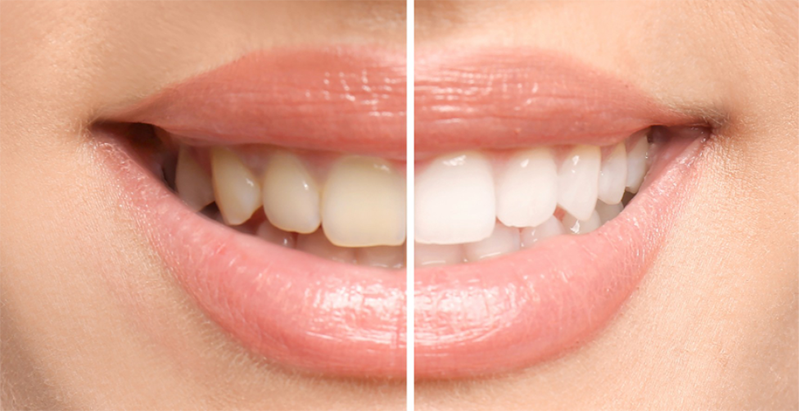
Extrinsic Stains:
Food and Drinks: Certain foods and drinks, like coffee, tea, and red wine, can discolour the enamel of your teeth. Tooth discolouration or yellowing can occur when these stains stick to the enamel's outer layer.
Smoking and Tobacco Use: The use of tobacco products, including cigarettes, is a major contributor to tooth discolouration, which can be yellow or brown in colour. The nicotine and tar in tobacco products attract and adhere to tooth enamel, strongly discolouring it.
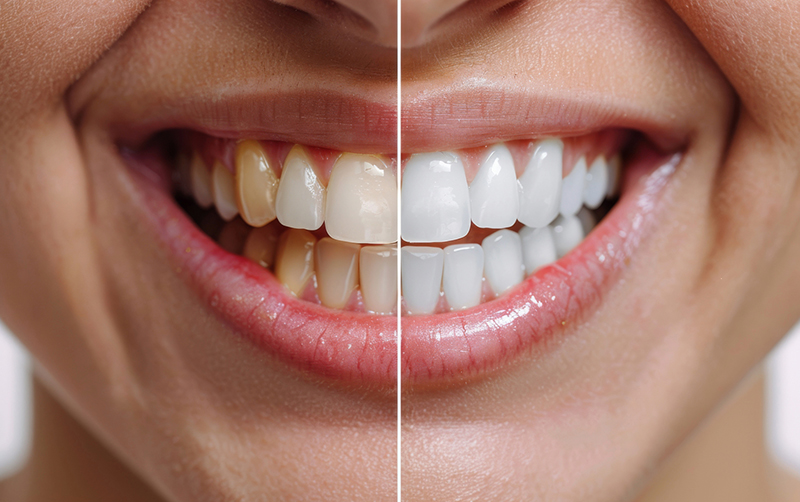
Intrinsic Stains:
Aging and Genetic Factors: As we grow older, the enamel covering of our teeth becomes thinner, revealing more dentin and making our teeth appear yellow. Another major component in tooth colour is heredity. Teeth can be naturally more yellow or grey for some people. Medicines: When used during tooth growth, certain antibiotics, particularly tetracycline, can cause teeth to become permanently discoloured on the inside. Because it originates within the teeth, this kind of discolouration is more resistant to whitening treatments. (1)
Despite the fact that daily tooth brushing is an excellent oral hygiene practice, there are a number of things that might make your teeth appear yellow. Among these reasons, the most significant one is the gradual loss of dental enamel that comes with getting older, which makes the dentin, a yellowish-colored portion, more noticeable. Furthermore, the enamel can be thinned in the same way as a result of overbrushing the teeth, according to the study. (3)
Several factors, including diet, tobacco use, heredity, medicine, and health issues, can influence tooth colour. Teeth can seem yellow for a variety of reasons, including internal discolouration, which even daily brushing can't completely eliminate, and external stains.
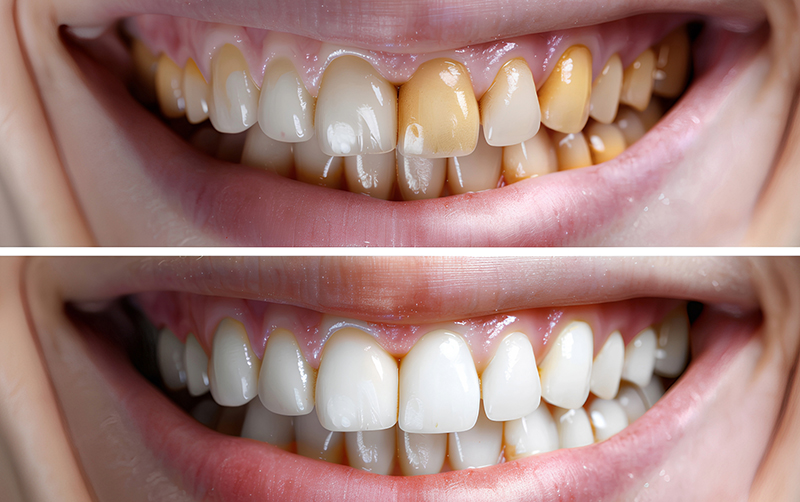
It is technically feasible to lighten antibiotic-induced tooth discolouration, although this type of discolouration is more commonly known as intrinsic discolouration and is notoriously difficult to remove. If you take certain antibiotics while your teeth are still developing, they could stain them permanently. This is especially the case with tetracycline. Advanced whitening methods, such as whitening with lasers or the KTP laser, can effectively remove these types of stains.
Teeth discolouration is a normal part of getting older. There are several reasons why this is the case: (2)
Thinning of the Enamel Layer: With age, the enamel layer, the outer layer of the teeth, becomes thinner. This thinning causes the underlying dentin layer to become more visible. The dentin layer has a more yellow color than the enamel layer, so teeth can take on a more yellow or darker shade over time.
Dentin Thickening: As we age, the dentin layer can also thicken, which contributes to teeth appearing darker.

Surface Staining: Habits such as years of food and drinks (coffee, tea, red wine, etc.) and smoking can cause stains on the surface of the teeth. These stains can accumulate over time and cause the teeth to have a darker color.
Intrinsic Discoloration: In addition to aging, some intrinsic factors can also affect tooth color. For example, long-term use of certain medications or antibiotics such as tetracycline taken during tooth development can cause permanent discoloration of teeth.
Changes in tooth structure: Chemical and structural changes that occur in the structure of the tooth during the aging process can also affect the color of the teeth.
In general, teeth-whitening techniques can be divided into four categories: over-the-counter products, home kits, professional applications, and natural techniques.
Professional In-Office Procedures
Professional teeth whitening procedures are performed in a clinical setting under the supervision of a dentist. These methods usually use whitening gels containing high concentrations of hydrogen peroxide (HP) or carbamide peroxide (CP). (video)
In-office whitening procedures performed in a professional dentist's office usually include the following steps:
Teeth Preparation:
The teeth are thoroughly cleansed before the operation starts, and a protective barrier is placed over the gums and other delicate tissues to ensure they are not damaged by the whitening solution.Having this shield in place keeps the whitening gels from harming the gums and other delicate tissues.
Application of the Whitening Gel:
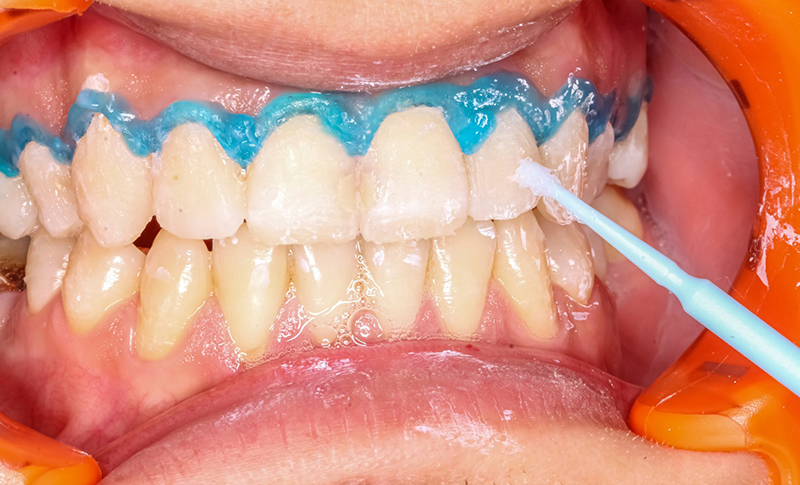
The dentist carefully coats the teeth with a whitening gel that has a high concentration of carbamide peroxide (CP) or hydrogen peroxide (HP). These agents break up stains on the teeth to start the whitening process.
Laser or Light Activation (Optional):
The whitening gel's effectiveness can be further amplified with the use of a laser or other specialised light source. By speeding up the gel's chemical processes, these activation methods enhance the whitening process.
Laser Activation:
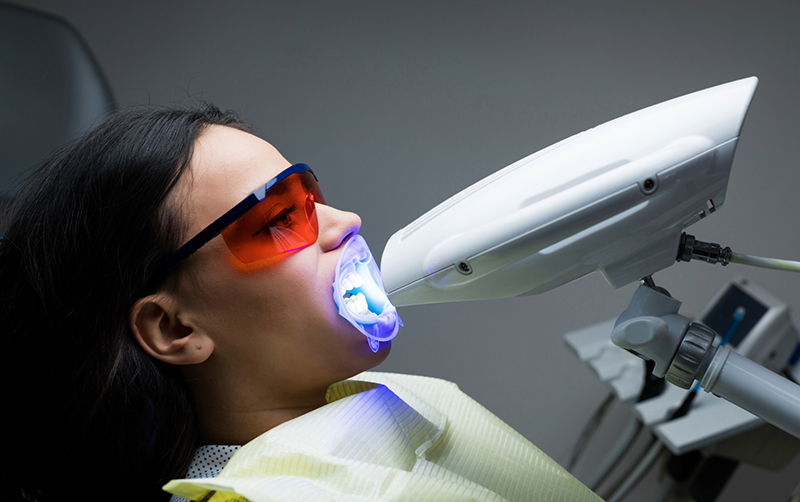
Lasers including diode, KTP, Er:YAG, and Er,Cr:YSGG lasers are all at the dentist's disposal. Teeth are whitened more quickly when exposed to laser light, which activates the peroxide molecules in the whitening gel and speeds up the process of free radical generation. Lasers cause photothermal or photochemical processes, which aid in the whitening process.
Light Source Activation:
Lighting alternatives to lasers include LED (light emitting diode) lamps and plasma arc lamps. The bleaching gel is heated or chemical processes are triggered by these light sources, which activate the process. Some clinics use blue UV light, which is often applied multiple times in 15-minute sessions.
Gel Retention Duration:
Teeth are left exposed to the whitening gel for a specific amount of time, often 15-60 minutes. At this point, the gel has begun to remove the spots by penetrating the tooth's enamel.
Cleaning the Gel and Repeating the Procedure:
At the end of the specified time, the whitening gel is carefully cleaned. If necessary, the dentist may repeat the whitening procedure one or more times. In some cases, the procedure is completed in more than one session10.
Final Check and Evaluation:
After the whitening procedure is completed, the dentist evaluates the new colour of the teeth and advises on additional procedures if necessary.
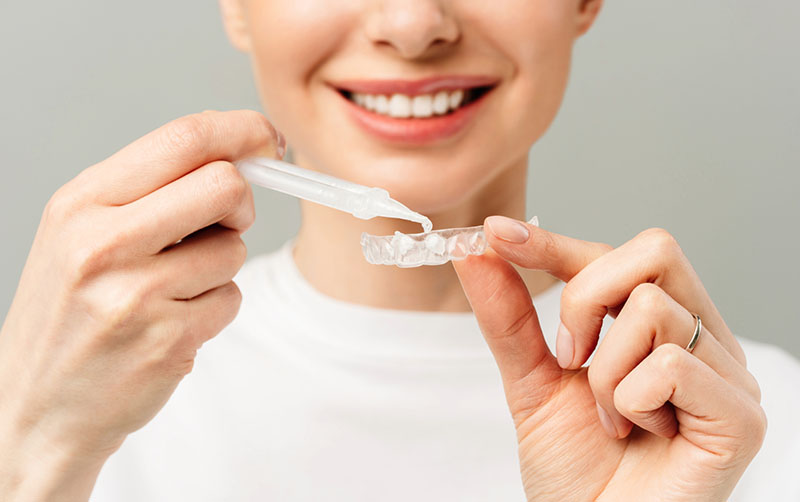
Teeth whitening trays are custom-made moulds that patients wear for a set amount of time while they have whitening gel applied to them. It is usually used at night or for a few hours during the day.
LED Light Kits: These kits include an LED light that activates the whitening gel once it is applied to the teeth. The whitening agent is made more effective with the help of the light.
- Pros
- Cost: It is more economical than professional methods.
- Ease of Use: It can be applied at home, according to one's own time.
- Continuity: Whitening can be continued as often as desired.
- Cons
- Slower Results: Slower results compared to in-office methods.
- Efficacy: Efficacy is lower than in-office procedures because lower concentrations of whitening agents are used.
- Sensitivity: Tooth sensitivity may occur.
- Errors in Use: In case of misuse or failure to follow the instructions, the desired results may not be achieved.
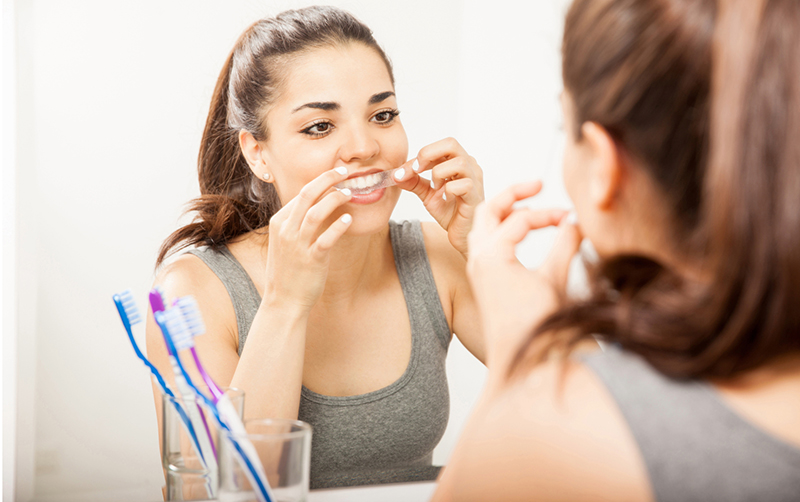
There are many different kinds of home whitening kits available, such as whitening strips, pens, mouthwashes, and toothpastes. The amounts of whitening chemicals in these products are often quite minimal.
- Whitening strips: Thin strips that are adhered to the teeth contain a whitening agent. It is used by leaving it on the teeth for a certain period of time.
- Whitening Toothpastes: They help to remove stains on the tooth surface with abrasive substances and low-concentration whitening agents.
- Whitening Pens: They contain whitening gels that are applied to the teeth with a brush or pen tip.
- Pros:
- Accessibility: They are readily available in pharmacies and grocery stores.
- Affordability: They are usually more affordable than other methods.
- Easy to use: They can be easily applied at home.
- Cons:
- Limited Effect: Their effectiveness is more limited than other methods. They work better on superficial spots, but may not be sufficient for internal spots.
- Slower Results: Results are slower and may require prolonged use.
- Sensitivity: May cause tooth sensitivity.
- Side Effects: Some products may cause irritation of the gums.
Procedure, product components, and application technique all have a role in the relative safety and danger of teeth whitening techniques. You can find the benefits and possible drawbacks of tooth whitening procedures here:
Does Whitening Damage Enamel?
Teeth whitening products with high levels of hydrogen peroxide have the potential to impact the enamel's structure. After bleaching, tooth enamel's microhardness, surface porosity, roughness, and calcium/phosphate ratio can change, according to many studies. The maximum concentration of HP that tooth whitening products can contain is 6%, as stated in EU Council Directive 2011/84/EU. (AB Konsey Direktifi 2011/84)
How Often to Whiten?
If you whiten your teeth too often, you run the risk of burning your gums, wearing down your enamel, and making your teeth more sensitive. The recommended frequency and length of teeth whitening operations as follows:
- Professional applications: Can be repeated twice a year, as recommended by the dentist.
- Home kits: Use as often and for as long as recommended by the dentist.
- Non-prescription products: For daily or weekly use, the instructions of the product should be followed.
When to Consult a Professional?
A dentist should be consulted in the following cases during the teeth whitening process:
- Severe tooth sensitivity or gum irritation
- Signs of significant damage to tooth enamel
- Failure to obtain satisfactory results after whitening
- Never having had a tooth whitening application before
- In cases where the cause of tooth discoloration needs to be determined
Hormonal changes during pregnancy can make the gums more sensitive and the risk of gingivitis (gingivitis) can increase. Therefore, it is important to take extra care of dental health during pregnancy. Since pregnancy, especially in the first trimester, is a critical period for the baby's development, caution should be exercised with any cosmetic or medical procedures, especially during this period. If teeth whitening is needed during pregnancy, dentists may recommend using low-concentration whitening products and postponing the procedure.
Too much hydrogen peroxide (HP) in certain whitening products could in fact change enamel structure. Following bleaching, some materials exhibit altered microhardness, porosity, roughness, calcium/phosphate ratio, abrasion resistance, and debris generation, according to research. (1)
The remineralisation effect of saliva, however, typically undoes these alterations. Using products with low concentrations and applying them correctly helps reduce the risk of enamel loss.
There have been similar results with laser-assisted whitening procedures:
- Some laser systems, such as diode laser (970 nm) and LED/laser (467 nm/790 nm), have been shown to cause slight changes in the enamel surface.
- Some studies suggest that whitening with diode laser has protective effects on the enamel structure. A study with a low-power diode laser (740 nm, 300 mW) showed that laser treatment preserved the enamel crystalline structure. (1)
Teeth whitening procedures can cause tooth sensitivity, especially when using highly concentrated products containing hydrogen peroxide (HP) or carbamide peroxide (CP). Bleaching agents penetrate enamel and dentin and stimulate nerve endings, which is the cause of this. Laser-activated bleaching methods can also trigger sensitivity by increasing pulp temperature
Low Concentration Whitening Products:
Choosing low concentration whitening gels instead of high concentration products can reduce the risk of sensitivity.
Short-Term Applications:
Applying whitening products for shorter periods of time can help prevent sensitivity. For example, with laser-assisted whitening, it may be beneficial to reduce the duration and frequency of laser application.
Fluoride Products:
Using products containing fluoride (toothpastes or gels) after teeth whitening can reduce sensitivity by strengthening and remineralizing tooth enamel.
Products containing potassium nitrate:
Potassium nitrate is an ingredient that helps reduce tooth sensitivity. Toothpastes or gels containing potassium nitrate can be used to reduce sensitivity after whitening.
Desensitization Gels:
Some dentists may recommend special desensitization gels to relieve sensitivity after whitening. These gels usually contain potassium nitrate or fluoride and soothe the dental nerves.
Calcium Phosphate Products:
Products containing calcium phosphate can be used to compensate for calcium loss and promote remineralization after whitening.
Painkillers:
In case of severe sensitivity, your dentist may recommend over-the-counter painkillers. However, it is important to consult a dentist before using painkillers regularly.
Teeth could be more vulnerable to discolouration in the initial two to four days following whitening. Keep away from anything that has any kind of colour when you're pregnant. Some examples of foods and drinks that usually fall into this group are:
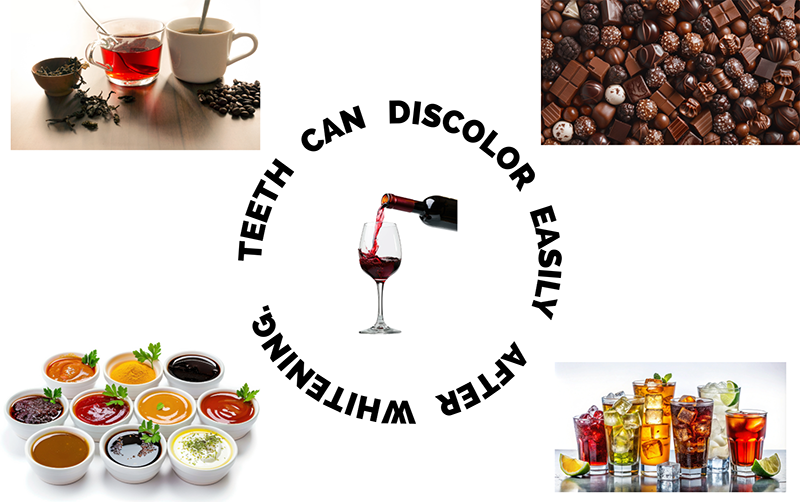
- Coffee and tea
- Red wine
- Cola and other carbonated drinks
- Colored fruit juices (cherry, blackberry, etc.)
- Colored sauces such as soy sauce, ketchup, balsamic vinegar
- Intensely colored vegetables such as beets, carrots
- Chocolate and colorful candies
- Dark-colored spices (turmeric, paprika, etc.)
It is OK to gradually reintroduce these foods and drinks after the initial 48 hours. Whitening effects last longer if you don't overuse it and cut back on how often you use it.
Other Recommendations:
- Water Consumption: Drinking plenty of water helps to remove colored pigments in the mouth.
- Light-colored foods: White meat, chicken, fish, yoghurt, and cheese can be liked.
- Fresh Fruits: Light colored and fibrous fruits such as apples and pears can be consumed.
Oral Hygiene Practices After Teeth Whitening
- Regular brushing: Brush your teeth at least twice a day with a fluoride toothpaste. When brushing, take special care to gently clean the gum line and all tooth surfaces.
- Flossing: Floss at least once a day to remove plaque and food debris from between teeth.
- Fluoride Mouthwash: Complete your oral hygiene by using a fluoride or antisensitizing mouthwash recommended by your dentist.
- Using Straws for Dark Drinks: Using a straw when consuming dark drinks can reduce the risk of staining by reducing direct contact with the teeth.
Follow-up Treatments and Maintenance
- Touch-up treatments: The permanence of whitening results may vary depending on the person's eating habits, oral hygiene and tooth structure. Generally, whiteness can be maintained for a period of 6 months to 2 years. Your dentist may recommend retouching treatments if deemed necessary.
- At-Home Whitening Kits: Your dentist can give you low-concentration whitening gels and special molds that you can use at home. These kits are ideal for touch-up treatments.
- Professional Check-ups: Regular check-ups with your dentist help you maintain your dental health and monitor whitening results. Your dentist can assess the color of your teeth and recommend additional whitening treatments or touch-ups if necessary.
Age limits, preexisting dental restorations, specific medical conditions, and whitening technology all play a role in determining which patients are good candidates for the procedure and which ones should not. Let's take a closer look at these unique situations and the factors that need to be taken into account:
Existing Tooth Restorations
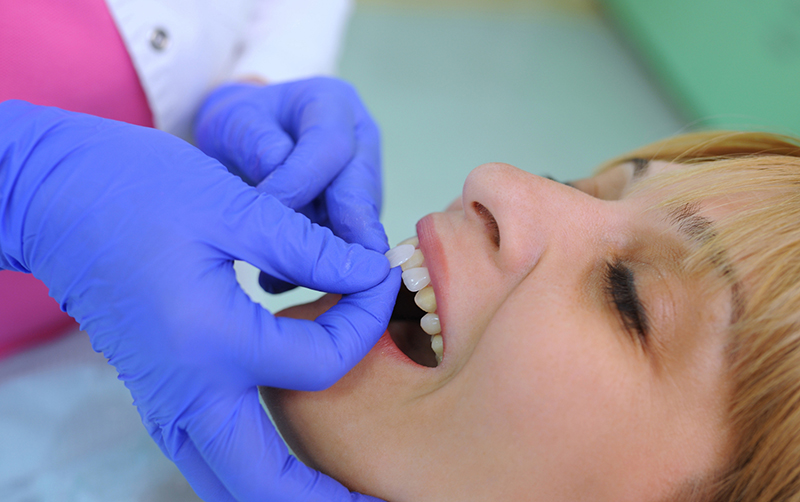
- Restorative materials such as veneers, crowns, fillings and implants do not whiten like natural teeth.
- While whitening gels remove discoloration from natural teeth, they do not change the color of restorative materials such as porcelain or composites.
- Therefore, after whitening, the color of your restorations may become incompatible with your whitened natural teeth. In this case, the restorations may need to be replaced.
- Composite fillings may not change color when exposed to bleaching agents. On the contrary, some composite fillers may discolor due to oxidation.
- The discoloration of ceramic materials can be removed by bleaching, but the resulting color will be the same as the initial shade.
- Restoration materials do not undergo discoloration, but in some cases, their structure may also deteriorate.
- Veneers and other restorations must be replaced after teeth whitening because their color does not respond to the whitening process.
Medical Conditions
- Sensitive teeth: Teeth whitening can cause or increase tooth sensitivity in some people. Your dentist may recommend specific desensitizing products or treatments to manage this condition.
- Gum disease: For people with gum disease, whitening can cause gum irritation or inflammation. You should consult your dentist before treatment to ensure that your gums are in good health.
- Pregnancy: Teeth whitening procedures are generally not recommended during pregnancy or breastfeeding. There is insufficient research on the potential effects of whitening products on mother and baby during these periods.
- In case of gingival recession, whitening may cause some sensitivity, as the root surface is exposed.
- In order not to increase the risk of root resorption, care should be taken with teeth whitening procedures.
Are LED Whitening Kits Better Than Traditional Whitening?
- LED light technology is a method used in teeth whitening procedures. Some studies show that LED light activation speeds up the whitening process and gives better results. However, other studies indicate that LED light activation does not make a significant difference in whitening effectiveness.
- It is thought that LED lights generate less heat than conventional whitening methods and may therefore reduce the risk of tooth sensitivity.
- Some studies suggest that LED lights produce results on par with diode lasers.
- The intensity, spectral distribution and irradiation time of the light used are important and studies suggest that these factors should be specified.
- The new generation of LEDs can provide higher power light than the older generations and could be an alternative to lasers for the activation of bleaching gels.
Below you can find the most frequently asked questions and answers about teeth whitening methods.
Do porcelain veneers whiten like natural teeth?
No, porcelain veneers do not whiten like natural teeth. While whitening gels remove discoloration from natural teeth, they do not change the color of restoration materials such as porcelain or composite. After whitening, the color of the veneers may become incompatible with your natural teeth, in which case they may need to be replaced. The discoloration of ceramic materials can be removed by whitening, but the resulting color will be the same as the initial shade.
Can I whiten my teeth with braces?
It can be challenging to whiten teeth when undergoing orthodontic treatment. Upon completion of treatment, you may like to think about having your teeth whitened.
Which Teeth Whitening Methods Really Work Best?
Although home kits promise faster results, professional teeth whitening performed in a dental clinic typically yields better results in a shorter amount of time. There are instances where laser-assisted whitening works better than other methods. For longer-lasting results, consider a combined treatment that includes both in-office and at-home whitening procedures.
Is Teeth Whitening Safe? Understanding the Risks and Side Effects
Whitening your teeth is usually a risk-free process, but it does come with some potential negative effects. Sensitivity to the teeth and gums are the most typical adverse effects. Too much whitener might actually wear out tooth enamel.
How Do I Prepare My Teeth for Whitening Treatment?
Prior to treatment, it is crucial to scale your teeth, assess your gum health, and address any cavities that may already be present.
What is the best way to protect my teeth after whitening?
To protect your teeth after whitening, you should regularly brush, floss, and take care of your oral care. Avoiding colouring foods and beverages and tobacco products will also help maintain whiteness for a long time.
How Much Does Professional Teeth Whitening Cost Compared to Home Kits?
In most cases, the cost of professional teeth whitening will be higher than that of at-home kits. On the other hand, professional treatments tend to yield better and faster results, while the efficacy of at-home kits can differ from one individual to the next.
Can Everyone Whiten Their Teeth? Who Should Avoid It?
Teeth whitening isn't for everyone. If you're pregnant or nursing, have gum disease, have extremely sensitive teeth, are young, or aren't sure if whitening is right for you, it's best to talk to your dentist.
What are the latest trends and innovations in teeth whitening?
Teeth whitening technologies are constantly evolving. Laser-assisted whitening, new generation LED lights, whitening products with natural ingredients, customized molds and combined treatments are among the latest trends.
Teeth Whitening Result: Is it worth it?
Those who desire a brighter smile may find that teeth whitening is an investment that pays off. However, it is important to assess your expectations and possible risks and consult a dentist before starting treatment.
What is the best way to whiten teeth?
The best way to whiten teeth depends on personal needs and expectations. It is important to consult a dentist and seek professional advice for the most effective and safe method.
Does teeth whitening damage tooth enamel?
When applied improperly or in excess, teeth whitening has the potential to harm tooth enamel. Less enamel damage can occur when you whiten according to your dentist's instructions.
How long does teeth whitening take?
The average duration of an professional whitening is six months to two years. Cigarettes, coffee, and tea are colouring chemicals that can reduce the effectiveness of teeth whitening products.
How to whiten teeth safely at home?
Your dentist may suggest a home whitening kit as a safe way to whiten your teeth. When using whitening products, be sure to follow the directions carefully and use the recommended amount and frequency of application. Stay away from home whitening solutions that aren't mindful.
Does whitening toothpaste really work?
Whitening toothpastes can help to remove surface stains, but they cannot significantly lighten the color of teeth. Rather, these pastes can be used to maintain the whiteness achieved after whitening.
What foods should I avoid after teeth whitening?
For at least two days following teeth whitening, you should refrain from consuming anything that can discolour your pearly whites, such as coffee, tea, red wine, soy sauce, etc. At this time, it's best to stick to white or light-colored dishes.
Is LED teeth whitening effective?
Yes, LED light-assisted whitening can be effective in some cases. LED light activates the whitening gel, helping to achieve faster results. However, some studies indicate that LED light activation does not make a significant difference to whitening effectiveness.
Can I whiten my teeth if I have sensitive teeth?
Yes, you can whiten your teeth even if you have sensitive teeth. However, in this case, your dentist may recommend special desensitizing products or treatment methods.
Is teeth whitening safe during pregnancy?
In most cases, it is not advisable to whiten your teeth while you are pregnant or nursing. The possible effects of teeth-whitening products on pregnant women and their unborn children have not been well studied.
Do whitening strips really work?
Whitening strips are a practical method to use at home. However, their effectiveness depends on the product used and the initial color of the teeth. They may not be as effective as professional treatments.
How can I reduce sensitivity after whitening?
Your dentist may suggest a desensitising toothpaste or gel to help alleviate any discomfort you may feel following teeth whitening. Staying away from beverages that are too hot or too cold might not hurt either.
Can charcoal or natural remedies help whiten teeth?
There is insufficient scientific data on the long-term effects and safety of such items. Avoid using products that are not suggested by your dentist. Charcoal and other natural therapies can help eliminate surface stains, but they will not lighten the colour of your teeth.
Can I whiten my teeth if I have crowns or veneers?
Unlike real teeth, dental veneers and crowns cannot be whitened. As a result, your restorations' colour may no longer blend in with your whitened teeth following whitening. The restorations might have to be changed out if this happens.
Why are my teeth still yellow despite brushing?
There are several potential causes of yellowing of the teeth, including heredity, ageing, specific foods and drinks, medicines, and medical disorders. You can find out what's wrong and figure out the best way to fix it by making an appointment with your dentist.
Does insurance cover cosmetic teeth whitening?
Insurance companies typically do not pay teeth whitening because they view it as a cosmetic procedure. Nonetheless, you should get in touch with your insurance provider or review your policy.
Recources:
- De Moor RJ, Verheyen J, Verheyen P, Diachuk A, Meire MA, De Coster PJ, De Bruyne M, Keulemans F. Laser teeth bleaching: evaluation of eventual side effects on enamel and the pulp and the efficiency in vitro and in vivo. ScientificWorldJournal. 2015;2015:835405. doi: 10.1155/2015/835405. Epub 2015 Mar 22. PMID: 25874258; PMCID: PMC4385673.
- Kiryk, J.; Kiryk, S.; Kensy, J.; Świenc, W.; Palka, B.; Zimoląg-Dydak, M.; Dobrzyński, W.; Matys, J.; Dobrzyński, M. Effectiveness of Laser-Assisted Teeth Bleaching: A Systematic Review. Appl. Sci. 2024, 14, 9219.
- Ahrari F, Akbari M, Mohammadpour S, Forghani M. The efficacy of laser-assisted in-office bleaching and home bleaching on sound and demineralized enamel. Laser Ther. 2015 Dec 30;24(4):257-64. doi: 10.5978/islsm.15-OR-15. PMID: 26877590; PMCID: PMC4751090.
Timeline to your new smile.
A more beautiful version of your present smile.
Dental Health is our super and only one specialisation.
Dental & oral health is our passion. The goal is a less obvious, natural and more beautiful version of your current smile and oral health.
Bright smile.
Illuminate your world with a smile that shines bright and exudes confidence.
Confidence booster.
Unlock your true potential with a smile that boosts your confidence.
Pure & perfect.
Experience the pinnacle of dental perfection with avita dental treatments.







